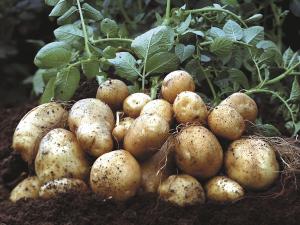With potatoes, sometimes laziness pays off
Revolving serving trays have been around since the 1700s. Because they took the place of a waiter, but were silent, they were called dumbwaiters. Soon they were called Lazy Susans from the popular English use of Susan as a generic term for a woman, much like the flower black-eyed Susan.
The lazy Susan was once associated with the perfectionist group of the Oneida Community who used them at the dinner table so everyone had equal access to food. Henry Ford brought a gigantic lazy Susan on his camping trips in the 1920s so he could leave the servants at home.
So lazy isn’t always a bad thing. This spring, gardeners might try being lazy. At least their potato beds should be a form of lazy bed.
The lazy bed was popular in Ireland, where farmers would dig trenches and hill up the land in four-foot-wide ridges.
These ridges are almost exactly the same as the wacho ridges planted by the Incas in the potato’s homeland of Peru and Bolivia.
The potato ridges warmed up quicker every day and retained heat longer at night. The slightly warmer temperatures also hold down blight.
This year, try making your own raised beds for potatoes. Plant potatoes in full sun in light, quick-draining soil. Potatoes grow best in slightly acid soil with a PH of 5.0 to 7.0, but they seem to grow under even less-than-ideal conditions. To prevent disease and insect pests, rotate your potato beds.
Potatoes are grown from small whole potatoes and cut potatoes called sets.
Get a head start by pre-sprouting your potatoes. Just set seed potatoes out for two weeks in full light and fairly warm temperatures between 60-70 degrees F.
The day before you plant the seed potatoes, cut any seed potato that is smaller than a regular chicken egg. Using a clean, sharp knife cut the seed potato so that each piece has two “eyes” or buds. Plant potatoes as soon as the ground can be worked in the spring. Plant your seed potatoes two to three inches deep and six to eight inches apart.
The potatoes will sprout in two to four weeks. Water potato plants whenever rainfall is less than an inch or two per week. Be sure to keep them well watered when the potatoes bloom and the few weeks after because this helps the tubers form.
You can save your own seed potatoes to plant next year. Choose your best potatoes that are healthy and free of blemishes. That said, for best results it pays to plant fresh, virus-free USDA Certified Seed Potatoes every spring.
While you can harvest potatoes any time, with soft new potatoes a special treat, if you want to store potatoes you should let the vines die down naturally before harvesting.
After digging your potatoes, let them dry in the sun for a few hours then store them in a dark, cool, (38-45 degree) spot with good air circulation.
Try something lazy this year and plant raised beds or lazy beds of potatoes. You might find fewer diseases and quicker crops. Laziness pays.














































